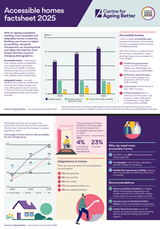The state of accessible housing - Accessible Homes Factsheet 2025

This factsheet, published by the Centre for Ageing Better, reveals how the gap between the number of accessible homes and the number of Disabled people has increased substantially, potentially leaving almost 13 million people to live in homes that don’t meet their needs.
It reveals that just 13% of homes in England have all four basic accessibility criteria that help make a home visitable for most people, namely:
- A toilet at entrance level
- Sufficiently wide doorways and circulation space for a wheelchair
- Level access to reach the front door
- A flush threshold with no obstructions that create a trip hazard or make it difficult for a wheelchair to cross
The factsheet shows how fewer than one in five homes (18%) have level access to the front door - with this figure dropping even lower for people aged 75 and above (17%). It also shows:
- The proportion of homes with level access has only increased by one percentage point since 2009.
- The proportion of homes with a toilet at entrance level in 2022 is 67% - an increase of just one percentage point since 2018 and just six percentage points since 2009.
- Progress on the inclusion of adaptions has similarly stalled over the past decade with the proportion of homes with a variety of life-changing accessibility adaptions not increasing since 2009.
- This includes grab rails (7% of all homes), stairlifts (2%), ramps (2%), adapted bathrooms (7%) and adapted kitchens (3%).
At a regional level in England, the Centre reports on the following trends:
- Older people living in the North East or the East Midlands are six times less likely to be living in a fully accessible home* compared to people living in London, this analysis from the Centre for Ageing Better reveals.
- Only one in 25 homes (4%) headed by someone aged between 55 and 64 in the North East or the East Midlands have all four accessibility features, compared to almost one in four (23%) in the capital.
- Only one in eight (13%) homes in England have all four accessibility features that mean they can be visited by someone with access needs, with substantial variation across different regions.
The Centre co-chairs the HoME Coalition, advocating for the mandatory adoption of Part M4(2) of the Building Regulations, and urging devolved regional and local authorities to incorporate these accessibility standards into their planning policies and design codes, as endorsed by the Housing & Ageing Alliance manifesto and the recent findings of the Older People’s Housing Taskforce.
